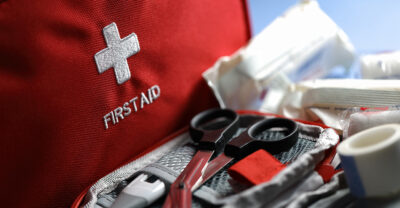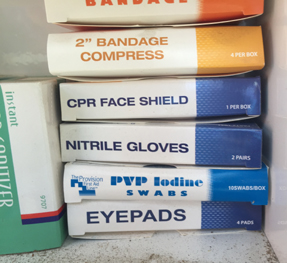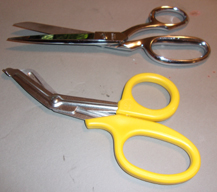
You should assemble a comprehensive first aid kit for your home, office and one for each car.
Other smaller kits for hiking / backpacking are advised.
Each Red Cross First Aid textbook says you can purchase various sizes of first aid kits from the Red Cross (redcross.org). And the Red Cross offers free apps about first aid:
https://www.redcross.org/about-us/news-and-events/news/Red-Cross-First-Aid-App-Can-Help-Save-Lives.html]
Just because a commercial first aid kit at the hotel pool has iodine swabs in it does not mean they are a good idea to use:
 See why at First Aid Facts and Fallacies. At that page you can also read why the manufacturer says “Krazy Glue products should not be used for wound care.”
See why at First Aid Facts and Fallacies. At that page you can also read why the manufacturer says “Krazy Glue products should not be used for wound care.”
Please note that some suggested trainings you find online (online only with no in-person skills work) are to start to learn first aid, but do not offer any certification you might require for work / your resume.
It is likely you do not need a pulse oximeter in your first aid kit:
The American Lung Assn said: “most pulse oximeters that are found on the internet or in drug stores are specifically labeled “not for medical use” and have not been reviewed by the FDA for accuracy. . . A pulse oximeter may be a recommended tool to use under the guidance of your healthcare provider to monitor symptoms, but it should not be relied upon without medical oversight, nor without paying heed to other signs and symptoms of illness.” And the American Heart Assn said: “pulse oximeters sold over the counter may not be approved or cleared by the US Food and Drug Administration or other regulatory agencies.”
The list below is taken from CDC (Centers for Disease Control) and Red Cross lists.
A suggested first-aid kit for a family of four could include the following items:
supplies to control bleeding (8 sterile pads; 4 x 4 inches, 5 sterile gauze pads 3 x 3-inch
or another list said: 2 absorbent compress dressings (5 x 9 inches)
(Do not use kleenex, toilet paper, cotton puffs that can disintegrate into the wound and need to be cleaned out.)
and supplies to secure large dressings (1 adhesive cloth tape (10 yards x 1 inch), 1 3-inch gauze roll (roller) bandage, 1 roller bandage (4 inches wide), a roll of paper tape to protect delicate skin, such as “elderly family members with fragile skin”
25 adhesive bandages (assorted sizes, shapes)
1 emergency blanket (aluminized flexible mylar emergency blanket)
1 breathing barrier (with one-way valve)
1 instant cold compress and/or large plastic bags to hold ice for application of ice water / create cold ice packs.
(at least) 2 pair of nonlatex gloves (size: large)
A thermometer (non-mercury/non-glass)
2 triangular bandages
Tweezers
A felt tipped pen can be useful to mark swelling as it starts to see how it progresses.
Trauma Shears – – heavy duty scissors to cut fabric without injuring the victim, with a wide, blunt tip instead of a sharp end.
Below see two pairs of scissors, one at the top of the photo with pointed ends and below it, with the yellow handle, note the blunt ends.

“If you or a family member lives with diabetes, include a juice box, glucose tablets and gels. . . oral glucose tablet – minimum 20 grams
The CDC (Centers for Disease Control) notes:
“Immediate replantation of an avulsed tooth is best, but if this is not an option, transporting the tooth in a solution like Hanks’ Balanced Salt Solution or in plastic wrap to a dental provider increases chances of tooth survival. Tap water should not be used as a transport medium.”
It was also suggested
“attaching a note to your kit with instructions on where to find other items around the house and how to act in specific emergencies. For example, you can use a note to remind you where sugary drinks and foods are kept in case of a diabetic emergency.”
“A person who is using a first-aid kit in an emergency might need to call 911 for assistance. Having the home or office address written on the outside of the kit itself can give users a handy location reference for 911 operators.” An emergency information form for each person in your household stored in each first aid kit is recommended.
They also recommend “Remove, throw away, or use and replace any supplies before they expire. Set a calendar reminder on your smartphone to update the supplies in your kit every six months and/or as the healthcare needs of your family change.”
In some countries there are legal requirements for a car first aid kit, which can include a warning triangle and a high-visibility vest for safety at the scene of a vehicle accident.
A flashlight in each vehicle, near each bed at home, your desk at work, a fanny pack or daypack while hiking, etc. could be also considered a part of your first aid kit.
See also:
Babysitter Consent and Contact Form
Store Water for After an Earthquake
A family (and babysitters, caregivers, overnight guests) disaster plan is at:
Disaster planning
As a part of preparing for the next earthquake, do a what if? survey of your home, crawl space, attic . .
earthquake home hazards survey
Wilderness First Aid outline
Times to suspect a spinal injury (symptoms, causes, signs of spinal injury)
How to pass a Red Cross written test
Bloodborne Pathogens quick facts
first aid Secondary Assessment
causes of fainting, altered mental status, sudden altered mental status, unconsciousness
Seizures, causes of and basic care for
Concussion signs and symptoms, prevention
The author of this webpage, (written as a homework reading assignment for my students), does not give any warranty, expressed or implied, nor assume any legal liability or responsibility for the accuracy, completeness, or usefulness of any information, product, or process included in this website or at websites linked to or from it. Users of information from this website assume all liability arising from such use.